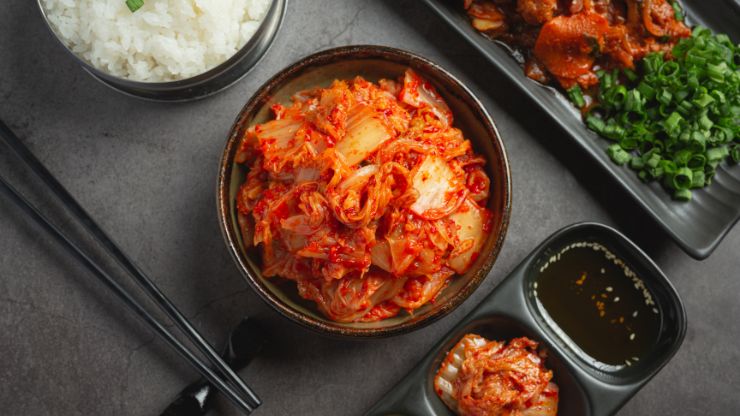Welcome to our “Homemade Kimchi Recipe Round-Up,” where we delve into the world of this iconic Korean condiment. Kimchi, with its fiery spiciness and tangy goodness, has taken the culinary world by storm. What’s more, crafting your very own kimchi at home is not only a delightful endeavor but also an opportunity to customize the flavor to your liking.
In this round-up, we’ll explore a diverse collection of homemade kimchi recipes. From traditional napa cabbage kimchi that stays true to Korean roots to inventive variations like fruit-infused or vegan options, our aim is to unlock the full potential of this beloved dish. We’ll also provide essential tips and insights to ensure your homemade kimchi journey is a flavorful success.
Whether you’re new to kimchi-making or a seasoned fermenting pro, this compilation offers a range of recipes and ideas to tantalize your taste buds. Get ready to embark on a kimchi adventure, as we celebrate the art of crafting your own fermented flavors.
Table of Contents
ToggleThe Beauty of Homemade Kimchi
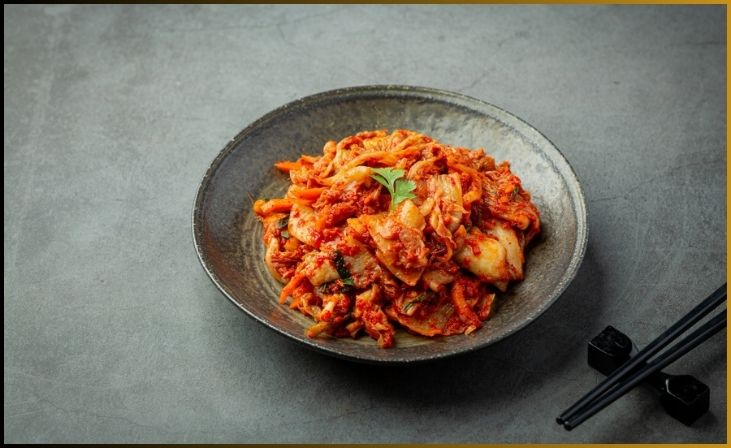
Homemade kimchi isn’t just about the end result; it’s about the journey and the connection to tradition. The process of making kimchi is rooted in Korean culture and history, where families come together to prepare vast quantities for the winter season. While modern kitchens may not require such large batches, the tradition of preparing and fermenting kimchi remains a heartwarming and flavorful experience.
Furthermore, creating your own kimchi gives you control over the ingredients, allowing you to choose organic vegetables, reduce sodium, and experiment with variations that aren’t commonly found in store-bought versions. You can adjust the level of spiciness, add unique ingredients, or even create fusion kimchis that incorporate elements from other cuisines.
Also Read- Delicious Kimchi Steamed Buns Recipe
The Basics of Making Kimchi
Before we dive into the homemade kimchi recipe round-up, let’s explore the fundamental steps and ingredients required to make this delectable dish. These are the key elements of any kimchi recipe:
Ingredients:
- Napa cabbage or Korean radish (daikon)
- Salt
- Water
- Korean red pepper flakes (gochugaru)
- Garlic
- Ginger
- Fish sauce or soy sauce (for umami)
- Sugar
- Green onions or chives
- Carrots (optional)
The Process:
- Salting: The first step involves salting the cabbage or radish. This draws out excess moisture and prepares the vegetables for fermentation. After salting, the vegetables are rinsed and drained.
- Kimchi Paste: The kimchi paste is the heart of the dish, consisting of Korean red pepper flakes, garlic, ginger, and other flavor-boosting ingredients. The paste is mixed with the prepared vegetables.
- Fermentation: Once the vegetables are coated with the kimchi paste, they are tightly packed into a container. It’s crucial to ensure there’s no trapped air to prevent spoilage. The kimchi is then left to ferment at room temperature for several days to develop its distinctive flavor.
- Storage: After the initial fermentation period, kimchi can be transferred to the refrigerator, where it continues to ferment at a slower rate. The longer kimchi is stored, the more its flavors intensify.
Homemade Kimchi Recipe Round-Up
Now that you’re acquainted with the essentials, it’s time to explore a variety of homemade kimchi recipes. From traditional napa cabbage kimchi to innovative interpretations, these recipes offer a delightful array of flavors and ingredients to suit every palate.
1. Traditional Napa Cabbage Kimchi
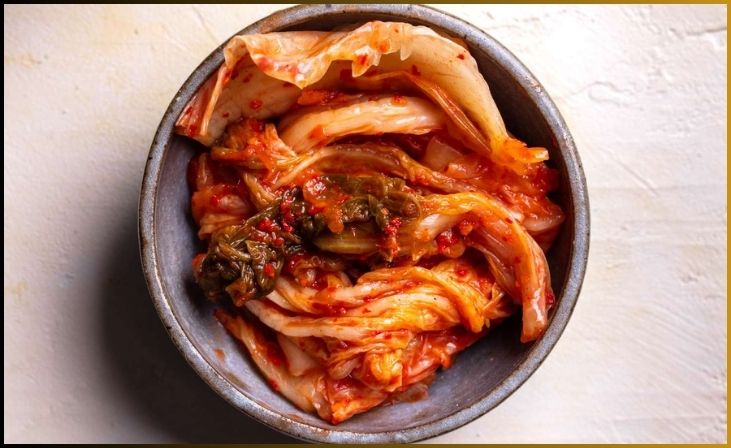
Traditional napa cabbage kimchi is the quintessential representation of this beloved Korean condiment. Characterized by its fiery spiciness and bold tanginess, it embodies the rich and authentic flavors that kimchi is renowned for. This classic recipe features napa cabbage as the primary ingredient, which is cut into pieces, salted, and then coated with a flavorful kimchi paste. The paste typically includes Korean red pepper flakes (gochugaru), minced garlic, grated ginger, fish sauce, and a touch of sugar, creating a potent and savory flavor profile.
As the kimchi ferments, the cabbage becomes tender, and the flavors intensify, resulting in a harmonious blend of spice and umami. Traditional napa cabbage kimchi is a staple in Korean cuisine, enjoyed as a side dish, an essential ingredient in various recipes, or even as a standalone treat. Its bold and complex flavors have made it a global culinary favorite, offering a taste of Korean culture to food enthusiasts worldwide.
2. Daikon Radish Kimchi
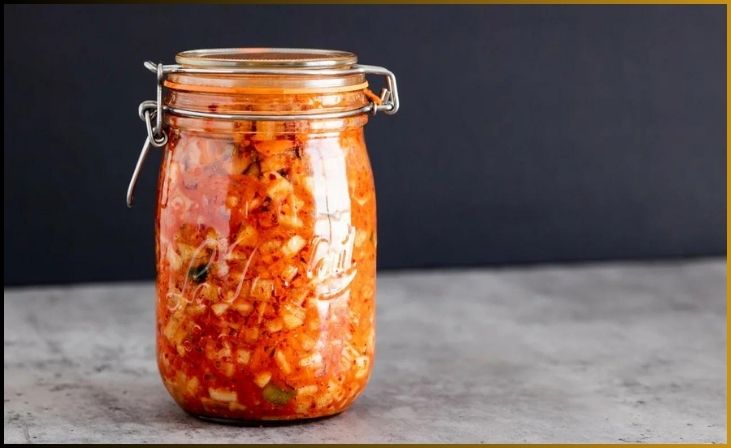
Daikon radish kimchi is a delectable variation of the classic Korean condiment that features daikon radishes as the star ingredient. This version of kimchi is celebrated for its mild, crisp, and refreshing qualities. Daikon radishes are known for their subtle sweetness and crunchy texture, making them a perfect choice for those who prefer a less spicy and more refreshing kimchi experience. The daikon radishes are typically cut into thin strips and then coated with a flavorful kimchi paste, which includes Korean red pepper flakes (gochugaru), garlic, ginger, and other seasonings.
The result is a kimchi that maintains the signature tangy and umami flavors but with a milder heat compared to napa cabbage kimchi. Daikon radish kimchi is a delightful addition to any Korean meal, offering a refreshing and crunchy contrast to the palate and showcasing the versatility of kimchi in its various forms.
Don't just scroll, subscribe!
BuzzTrail's unique web-stories are the cure for boredom you've been waiting for.
3. Vegan Kimchi
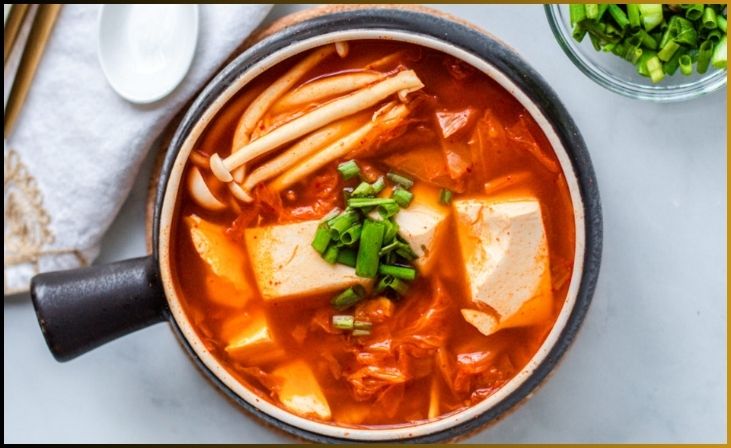
Vegan kimchi is a plant-based twist on the traditional Korean dish, offering a delicious and cruelty-free alternative to the classic recipe. It replaces fish sauce, a common ingredient in traditional kimchi, with soy sauce or tamari, ensuring that no animal-derived components are included.
The result is a savory, spicy, and tangy kimchi that remains true to the signature flavors of this iconic condiment while catering to a vegan diet. This variation is a testament to the adaptability of kimchi-making, highlighting how traditional recipes can be modified to accommodate different dietary preferences and restrictions. Vegan kimchi is a flavorful and satisfying option for those seeking a compassionate and plant-based approach to this beloved Korean staple.
4. White Kimchi
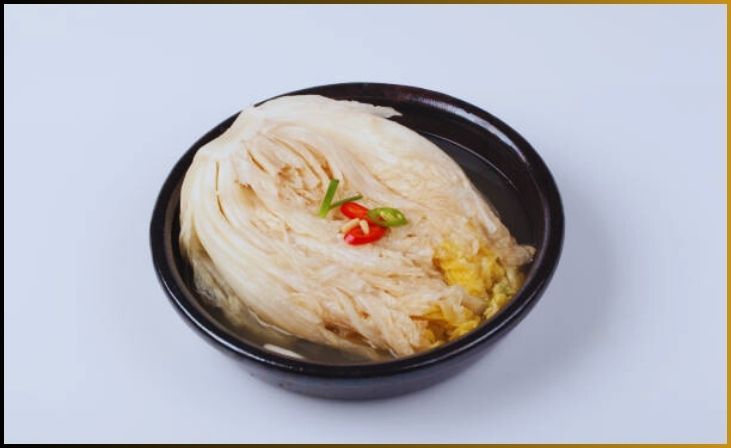
White kimchi is a delightful departure from the fiery and vibrant red hue typically associated with traditional kimchi. Hailing from South Korea, this variation offers a milder and non-spicy take on the iconic dish. What sets white kimchi apart is the absence of Korean red pepper flakes (gochugaru), which lends it the characteristic spicy kick. Instead, white kimchi boasts a subtle sweetness, often achieved by incorporating ingredients like julienned Asian or Korean pears.
The flavors are further balanced with a hint of ginger and garlic. This milder profile makes white kimchi an excellent choice for those who prefer a more gentle and slightly sweet taste. It’s a fantastic option for children or individuals with a lower tolerance for spiciness. White kimchi is a reminder of the versatility of kimchi, showcasing that this beloved Korean staple can be adapted to cater to various flavor preferences.
5. Fruit-Infused Kimchi
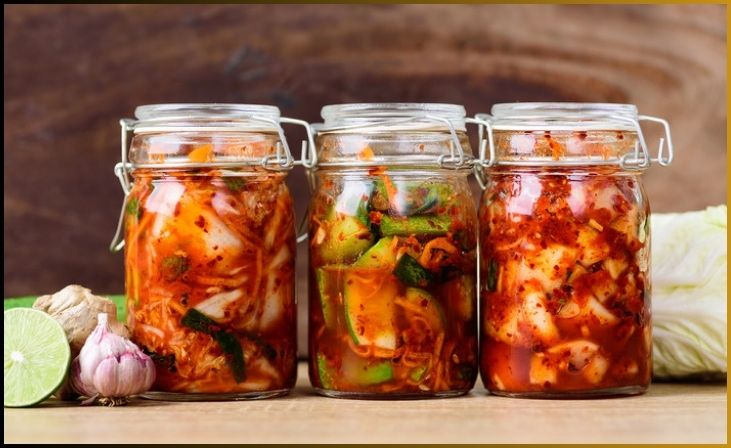
Fruit-infused kimchi is a creative twist on the traditional Korean condiment, introducing a hint of sweetness and unique fruity flavors into the mix. By incorporating fruits like apples or pears, this innovative variation brings a delightful contrast to the typically spicy and tangy kimchi. The fruits not only contribute their natural sweetness but also lend a pleasing textural dimension to the dish. As the kimchi ferments, the fruits undergo a transformation, becoming slightly softened and absorbing the spicy notes from the kimchi paste.
The result is a harmonious balance of sweet and savory, making fruit-infused kimchi an excellent choice for those who prefer a milder and fruit-forward kimchi experience. This variation is a testament to the adaptability and creativity that kimchi-making allows, and it offers a refreshing and unique take on a beloved Korean classic.
6. Kimchi with Seafood
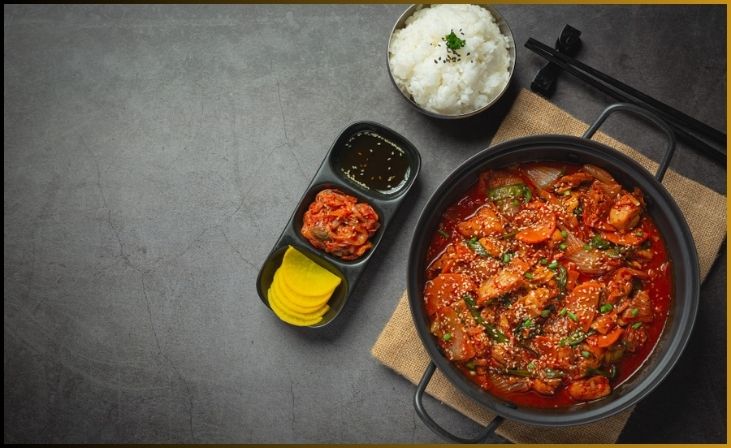
Kimchi with seafood is a delightful variation of the traditional Korean dish that introduces the savory and umami notes of seafood into the mix. This unique take on kimchi incorporates small seafood such as oysters or shrimp as an additional layer of flavor. The brininess and oceanic undertones of the seafood combine harmoniously with the spicy and tangy elements of the kimchi paste.
The result is a complex and dynamic taste profile that adds a depth of richness to the dish. The seafood, once fermented, becomes tender and imparts a distinctive umami flavor to the kimchi. Kimchi with seafood is a favorite among seafood lovers, offering a delightful fusion of land and sea, and it’s often enjoyed as a side dish or a flavorful ingredient in various Korean recipes.
Tips for Perfect Homemade Kimchi
Achieving the perfect homemade kimchi requires attention to detail and a few tips to ensure that your creation turns out beautifully. Here are some tips for perfect homemade kimchi:
- Hygiene is Key: Hygiene is a critical factor when making homemade kimchi. Ensuring a clean and sanitized work environment, along with clean utensils and hands, is essential to prevent harmful bacteria from contaminating the kimchi during the fermentation process. A hygienic setting minimizes the risk of spoilage and ensures the safety and quality of the final product. It’s a fundamental step in creating delicious, safe, and perfectly fermented kimchi.
- Quality Ingredients: Using quality ingredients is essential when making homemade kimchi. Fresh, high-quality vegetables like napa cabbage or daikon radish are the foundation of a great kimchi. Likewise, ensuring your spices and seasonings are fresh and well-stored contributes to the overall flavor and quality of your homemade kimchi. Quality ingredients provide the vibrant and authentic flavors that make this iconic Korean dish so delectable, ensuring a successful and satisfying kimchi-making experience.
- Even Salting: Even salting is a crucial step in making homemade kimchi. During the initial salting phase, it’s important to ensure that every piece of vegetable is coated evenly with salt. This not only enhances the flavor but also draws out excess moisture from the vegetables, an essential step for proper fermentation. An even salting process ensures that your kimchi will have the right texture and consistency, contributing to its overall quality and deliciousness.
- Taste Testing: Taste testing is a key element in the kimchi-making process. During fermentation, it’s important to sample your kimchi to assess its flavor and level of fermentation. Kimchi should develop a tangy and slightly effervescent taste when it’s ready. This step allows you to customize the fermentation process to your preference, ensuring that your homemade kimchi has the perfect balance of flavors before transferring it to the refrigerator for long-term storage.
- Fermentation Time: Fermentation time is a critical aspect of homemade kimchi. The duration of fermentation varies depending on factors like temperature and personal taste. It’s important to start tasting your kimchi after a day or two, as this helps you gauge the level of fermentation. When the kimchi reaches the desired flavor, you should transfer it to the refrigerator to slow down the fermentation process. This ensures that your kimchi is not overly sour and maintains the right balance of flavors for your enjoyment.
- Well-Sealed Containers: Using well-sealed containers is essential when storing homemade kimchi. Airtight containers prevent exposure to air, which can cause spoilage and negatively impact the flavor and quality of the kimchi. Ensuring a tight seal maintains the unique and delicious flavors of your kimchi, preserving its freshness for an extended period in the refrigerator. This step is crucial to keep your kimchi in optimal condition until you’re ready to savor its fermented goodness.
For More- A Basic Sauerkraut in a Jar Recipe
Bottom Line
In the world of homemade kimchi, the journey is as enticing as the destination. The art of crafting your own kimchi allows you to connect with a rich culinary tradition and create a flavorful masterpiece that suits your unique taste. From the spicy and traditional napa cabbage kimchi to innovative interpretations with fruits or seafood, the possibilities are endless.
Homemade kimchi offers not only customization but also a sense of accomplishment and a connection to a dish that has been enjoyed for generations. Whether you’re a novice or a seasoned fermenter, these recipes open the door to a world of fermented flavors. So, roll up your sleeves, gather your ingredients, and embark on a kimchi-making adventure. Enjoy the process, experiment, and savor the satisfaction of creating your very own homemade kimchi.
FAQs
How long can I store homemade kimchi in the refrigerator?
How long can I store homemade kimchi in the refrigerator?
Homemade kimchi can be stored in the refrigerator for several months. Its flavor will continue to develop over time. Be sure to keep it in an airtight container for the best preservation.
Can I adjust the spice level in homemade kimchi recipes?
Can I adjust the spice level in homemade kimchi recipes?
Yes, you can adjust the spice level by varying the amount of Korean red pepper flakes (gochugaru) in your kimchi recipe. Add more for extra heat or reduce it for a milder flavor.
Is there a vegan alternative to fish sauce in kimchi recipes?
Is there a vegan alternative to fish sauce in kimchi recipes?
Absolutely! You can substitute fish sauce with soy sauce or tamari for a vegan-friendly kimchi.
What is the white kimchi variation?
What is the white kimchi variation?
White kimchi is a milder, non-spicy version that is typically made without Korean red pepper flakes. It has a mild, slightly sweet flavor.

